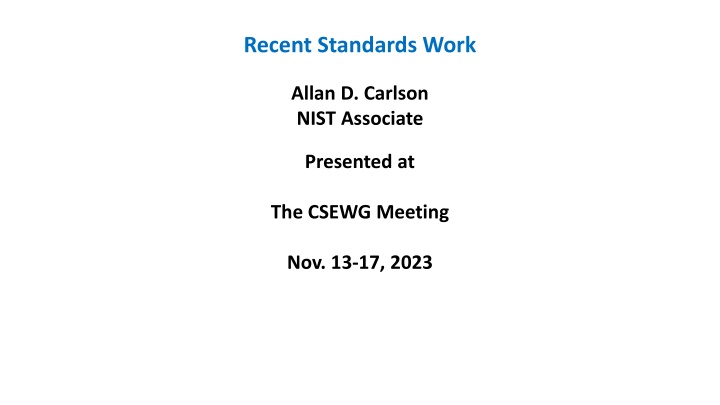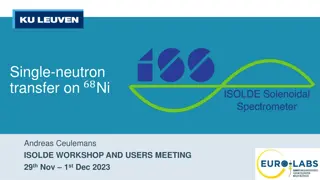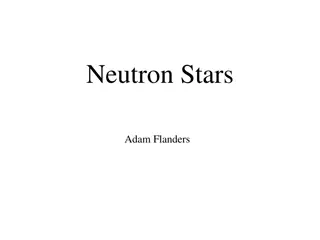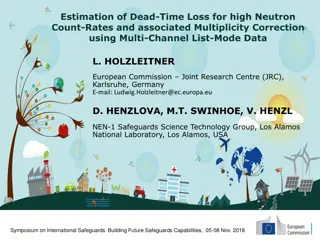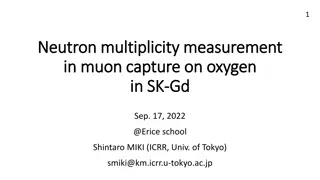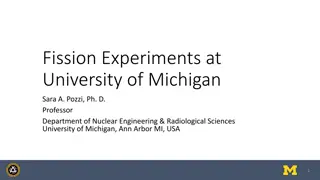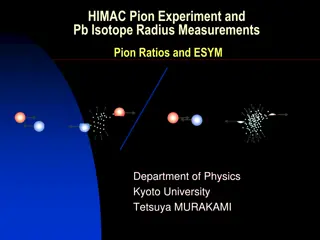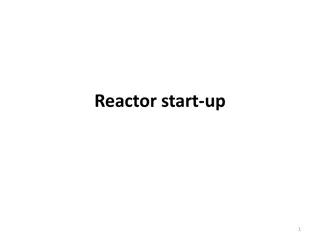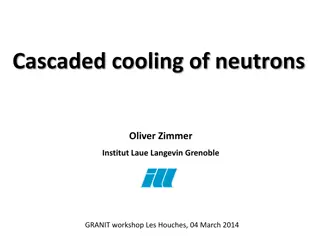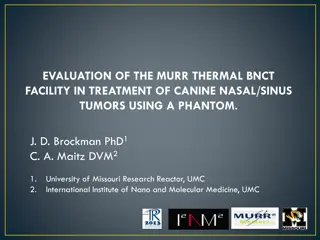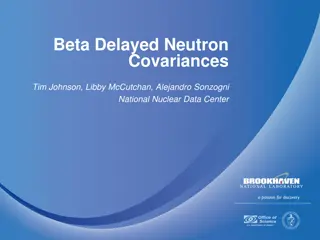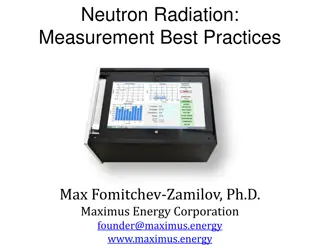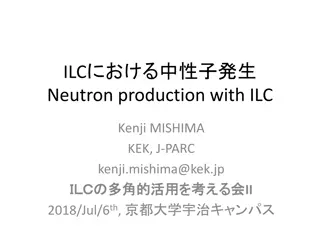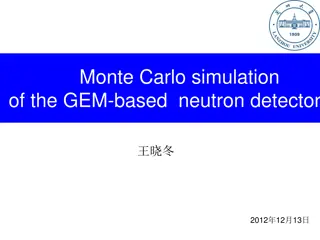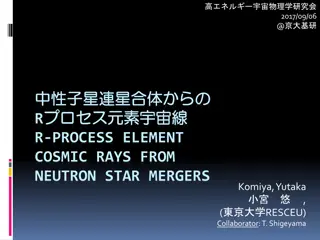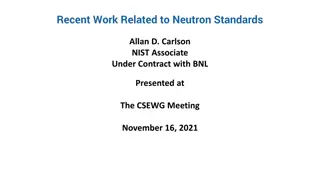Neutron Cross Section Standards Analysis
This content discusses recent standards work on neutron cross sections, including measurements, reactions, and experimental findings presented at various meetings. It covers a range of standards such as H(n,n), 3He(n,p), 6Li(n,t), and more. The focus is on recent work, measurements, and cross-section ratios related to 235U(n,f) and 6Li(n,t). Various experiments and results, including those from the Chinese Spallation Neutron Source, are examined to provide insights into neutron cross section standards.
Download Presentation

Please find below an Image/Link to download the presentation.
The content on the website is provided AS IS for your information and personal use only. It may not be sold, licensed, or shared on other websites without obtaining consent from the author.If you encounter any issues during the download, it is possible that the publisher has removed the file from their server.
You are allowed to download the files provided on this website for personal or commercial use, subject to the condition that they are used lawfully. All files are the property of their respective owners.
The content on the website is provided AS IS for your information and personal use only. It may not be sold, licensed, or shared on other websites without obtaining consent from the author.
E N D
Presentation Transcript
Recent Standards Work Allan D. Carlson NIST Associate Presented at The CSEWG Meeting Nov. 13-17, 2023
The Neutron Cross Section Standards Reaction Energy Range _________________________________________________ H(n,n) 1 keV to 20 MeV 3He(n,p) 0.0253 eV to 50 keV 6Li(n,t) 0.0253 eV to 1 MeV 10B(n, ) 0.0253 eV to 1 MeV 10B(n, 1 ) 0.0253 eV to 1 MeV C(n,n) 10 eV to 1.8 MeV Au(n, ) 0.0253 eV, 0.2 to 2.5 MeV, 30 keV MACS 235U(n,f) 0.0253 eV, 7.8-11 eV, 0.15 MeV to 200 MeV 238U(n,f) 2 MeV to 200 MeV
Outline of Recent Work on the Neutron Standards Measurements of Neutron Cross Section Standards Proposed, Underway or Completed Including results presented at the Oct 2023 Standards meeting Due to time limitations for this presentation mostly very recent work will be discussed. The reference cross section areas will not be shown: Prompt -ray production Reference cross section measurements 7Li(n, n ) and 48Ti(n,n ) Reference cross sections
Previous CSNS Measurements The measurements at the Chinese Spallation Neutron Source discussed last year have been published Light element standards Measurements by Jiang, et al. of the hydrogen angular distribution from 6-52 MeV * Measurements of the 6Li(n,t) angular distribution by Bai et al. for energies from 1 eV to 3 MeV* Angular distribution data obtained by Jiang et al. for the boron standards from 1 eV to 2.5 MeV* Ratios of the 10B(n, )7Li reaction to the 6Li(n, t)4He reaction by Liuet al. to several MeV* Fission Data The 235U(n,f) and 238U(n,f) cross sections relative to n-p scattering by Chen et al from 10 to 66 MeV* All the experiments above (with*) were done using the double bunch mode for the accelerator. That mode has 2 bunches of pulse width ~ 41 ns: 410 ns was the interval between proton bunches. the neutron energy distribution caused by the double proton bunches was unfolded using an iterative unfolding method. The 238U(n,f)/235U(n,f) cross section ratio by Wen, et al. from 1 to 20 MeV. This is the only experiment done using the single-bunch mode with ~ 41 ns width .
6Li(n,t) Measurements Measurements are being made by Anastasiou et al. of the 235U(n,f)/6Li(n,t) cross section ratio with the NIFFTE fission TPC. The expected energy range is from about 0.1 MeV up to 3 MeV (possibly 4 MeV). The data will impact evaluations of both the 235U(n,f) and 6Li(n,t) cross sections. Some results of this work were given by Anastasiou at the ND2022 conference and the 2023 standards meeting . Preliminary results were given that agree well with the standards evaluation and suggest a rise in the ratio above 1 MeV.
235U(n,f)/6Li(n,t) Cross Section Ratio Measurements by Anastasiou et al.
Measurements Directly Related to the 10B(n, ) Standardand 10B(n, 1 ) Measurements Massey et al. have measured 10B(n,Z) reactions for neutron energies from 2 to 20 MeV. The work was done at the LANSCE WNR facility (Phys. Rev. C 105, 054612 (2022)) More work by Massey et al. Several measurements of the 10Be(p,n)10B reaction by Massey and Jones-Aberty at Ohio University. They include two angular distributions at 2.5 and 3.5 MeV. All of these data can be used in R-matrix fits to improve the 10B(n, ) standards
10B(n,x)7Li and Li Measurements Extension in the energy ranges to above 1 MeV of the 6Li(n,t) and 10B standards may be possible with the work byAnastasiou et al., Bai et al., Jiang et al. and the Massey et al. data. The It is important to extend the energy range of these standards to above 1 MeV, the present limit of this standard. That would allow convenient overlap with the H(n,n) standard.
C(n,n) Cross Section The most recent evaluation of the carbon standard by Hale was done by combining 12C and 13C R-matrix evaluations to obtain the elemental cross section that is the standard. That evaluation, the ENDF/B-VIII standards evaluation (the 2017 standard), is somewhat higher than the ENDF/B-VII standards evaluation (the 2006 standard). The difference is most noticeable at the highest energies. At the standards meeting in October, Hale indicated he is working on a new evaluation of neutrons on carbon. The use of high energy data in the evaluation has caused an decrease in the C(n,n) cross section in the standards energy region by about a percent . So now it is closer to the 2006 standards values in the higher energy region Measurements have been made by Vanhoy on 13C that should improve the new evaluation of the carbon Standard. Carbon scattering measurements by Kelly at LANL are also underway that should impact the new evaluation.
C(n,n) Cross Section Angular distribution measurements have recently been completed at GELINA by Gkatis et al. The data were obtained with the ELISA setup Energies from 10 mV to 20 MeV ( thus covering the standards energy range) With 8 angles between 16.2 and 163.8 degrees
Uranium Fission Cross Section Measurements Absolute measurements by the n_TOF collaboration were made of the 235U(n,f) cross section relative to hydrogen scattering from 20 MeV to about 1 GeV. The status of the analysis of the data was discussed by Manna et al.at the October standards meeting. The analysis is essentially completed for the energy region up to 450 MeV. The results up to 450 MeV are similar to those of the 235U(n,f) Reference cross section The present standard is limited to 200 MeV. There is a strong need for an extension to higher neutron energies that may be possible with these data if high accuracy can be obtained. Their plan is to have a further campaign to Improve the accuracy (reduce the statistical uncertainty) Go to higher neutron energy The fission fragment detectors already extend to 1 GeV Getting to higher proton energy data will require being able to separate the elastic and inelastic protons since inelastic scattering is a problem at the higher neutron energies
235U(n,f) Cross Section Measurements by Manna et al. En (MeV) En (MeV)
235U(n,f) Cross Section Uncertainties for Manna et al. Measurement
Uranium Fission Cross Section Measurements 235U(n,f) and 238U(n,f) cross sections measurements at CSNS Shown by Chen. at the October standards meeting. Relative to the hydrogen scattering standard-shape data For the extension up to 70 MeV problems were noted due to the use of double bunches. The unfolding causes a problem that is worsened when statistical uncertainties are large. More work is planned They now extend from 10 to 66 MeV
235U(n,f) Cross Section Measurements by Chen at CSNS Facility
Use of Integral Data Beginning with the standards for the ENDF/B-VI evaluation, very clean integral data were used. The data used were measurements of the 235U(n,f) and 239Pu(n,f) cross sections in the 252Cf spontaneous fission (neutron spectrum (Spectrum Averaged Cross Sections, SACSs). Since there is a relatively small change in the cross section for these nuclides over most of the energy range of the 252Cf spectrum, an accurate determination of the cross section is possible. The result is also only weakly dependent on the uncertainty in the spectrum shape. These integral data basically help provide normalization for the standards evaluation. An improvement in use of these SACS would be possible if ratios can be used. With ratios, the dependence on neutron fluence is removed. GMAP unfortunately can not handle SACS ratios A new Python based code was written by Schnabel (GMA-py) so that ratios can now being used. Using the the 239Pu(n,f)/ 235U(n,f) SACS ratio data and the 238U(n,f)/ 235U(n,f) SACS ratio data and the data in the GMA data base has led to a new preliminary evaluation of the standard cross sections. For example, more than a0.6% increase in the 239Pu(n,f) /235U(n,f) cross section ratio occurs.
Plutonium Fission Cross Section Related Measurements 239Pu(n,f)/235U(n,f) cross section ratio measurements by Snyder et al. made at LANSCE by the NIFFTE collaboration have been published (L. Snyder, Nuclear Data Sheets 178 1 (2021) ). These data are higher than the standards evaluation by slightly less than 2%. They are recommended to be used as ratio shape data. They agree in shape with the 2017 standards evaluation. New measurements have been made with an improved sample. They were shown at the ND2022 conference and at the recent Oct. standards meeting by Snyder. The new data look identical to the former measurements. But each of those measurements was normalized at the same low energy. It s normalization is still under investigation. As noted previously, work with GMA-py led to a new preliminary standards evaluation that yielded a 239Pu(n,f)/235U(n,f) cross section ratio with a value that is more than 0.6% larger than the value obtained with the 2017 standards evaluation. So the difference now instead of 2% it is just slightly more than 1% compared with the present preliminary standards evaluation. Also measurements have been made of the 239Pu(n,f)/6Li(n,t) cross section ratio with the NIFFTE fission TPC. These data will impact evaluations of both the 239Pu(n,f) and 6Li(n,t) cross sections. These data are not finalized.
Comparison of the Published NIFFTE 239Pu(n,f)/ 235U(n,f) Cross Section Ratio with the Standards Evaluation
Nuclear Reaction Activities- Measurements Comparison of measurements of neutron source emission rate CRR(III)-K9.Cf 2016 NIST is a participant in an international project measuring source intensity A single 252Cf is sent to a number of laboratories throughout the world Brazil, Canada, China, England, France, Italy, Russia, S. Korea and USA The measured rate at each laboratory using their techniques is sent to a pilot institute The results are being tabulated leading to a publication in Metrologia Such work is valuable to ensure that each laboratory is obtaining consistent results Results that deviate from the mean require investigation to find sources of error
Summary-what is needed Improved experimental work is necessary for all the standards Especially the boron and lithium standards so the upper energy bound can be increased Also for gold capture that has some of the largest uncertainties for the standards Extension of the hydrogen standard to about 150 MeV and possibly higher (work is underway by Hale and Paris) It is now 20 MeV but there are cross section ratio data to much higher energies Note that changes to a standard are not allowed for a given version but extensions are allowed Further work on unrecognized sources of uncertainty An understanding of the energy dependence of USU Consider improved evaluation techniques for the standard cross sections
Pu9f/U5f: 2017 vs current GMA-py @ 1.5 MeV +0.2% due to SACS +0.3% rel. to INDEN p57
